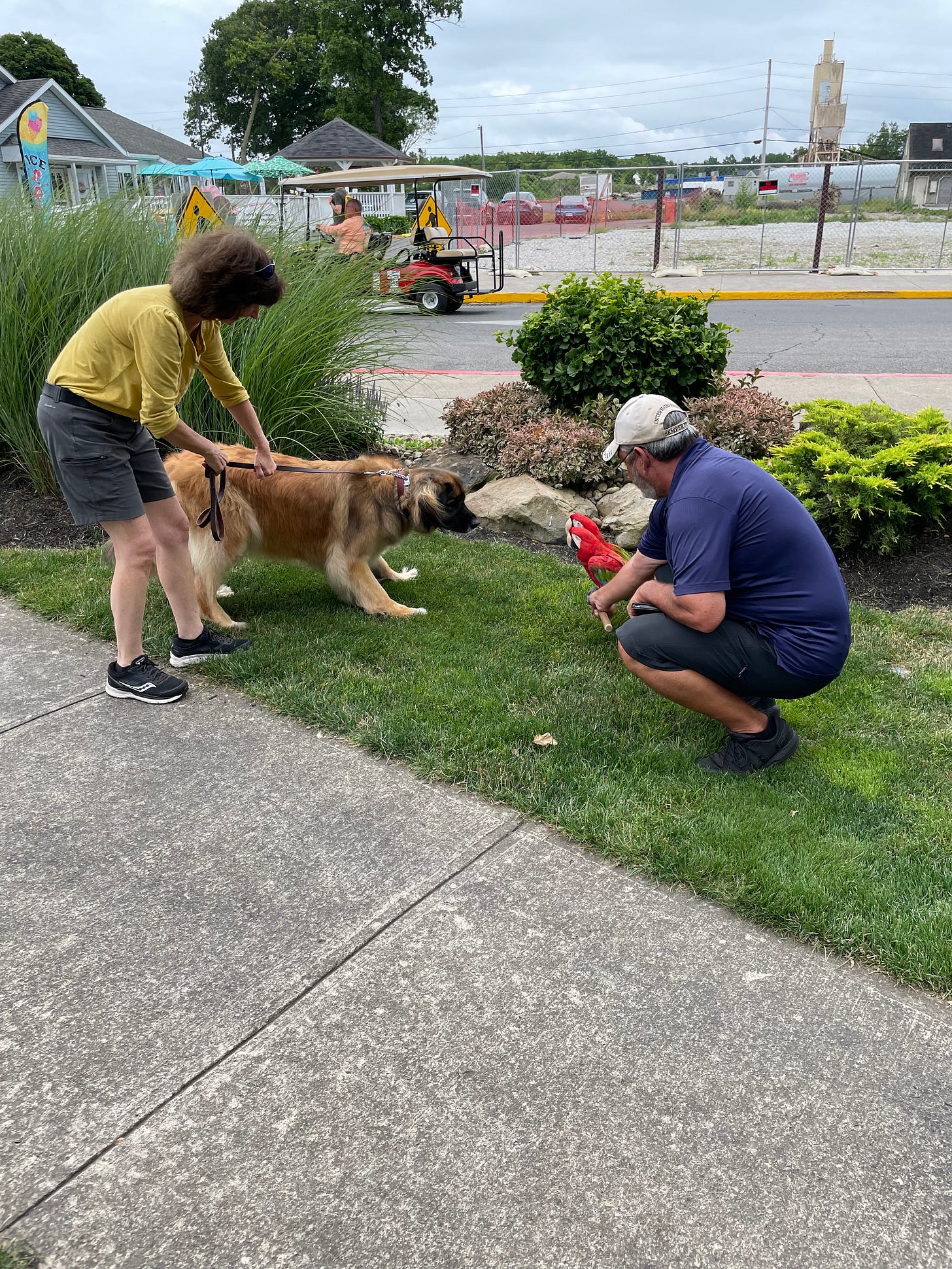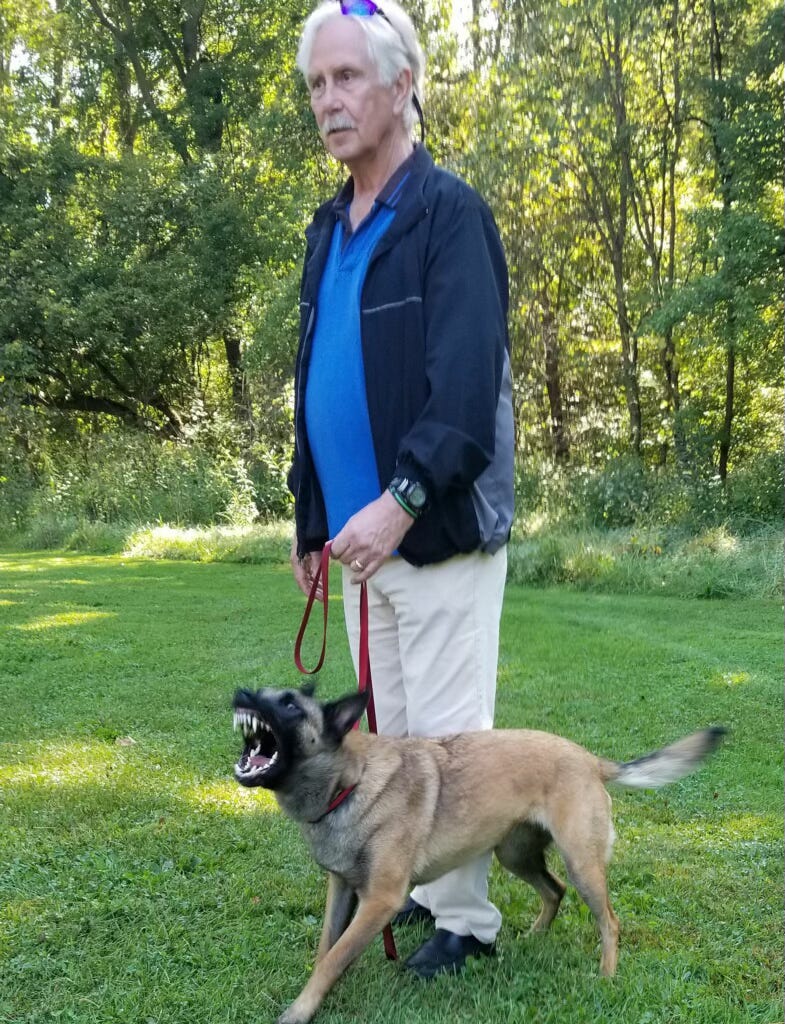E-collars (electronic collars) or shock collars are used in dog training for different reasons. Some dog trainers use them almost exclusively, and others use them for specific purposes. My knowledge and experience is limited with e-collars due to my background. As I have mentioned before, I was trained at Petco. E-collar training was not part of their program. However, I met a lot of clients during my time as a trainer there and even more clients when I started my own business who would tell me that they tried an e-collar and it didn’t work. I could not offer any assistance or feedback, even though e-collars were sold in the store. My lack of knowledge and inability to help, motivated me to learn about them.
Luckily, I know Gary Flynn, from The Dog Advocate, from our days at Petco. The more I got to know Gary, the more I knew that he was the one I wanted to learn from. I knew that he had used e-collars before in his professional career before working at Petco. I had a lot to learn when I started my own dog training business, so learning about e-collars was not a priority. There were so many other issues to focus on first. It wasn’t until about 3 years ago that I felt it was time to learn about e-collars so that I could help my clients more.
I had a sneaky suspicion that the whole reason people weren’t having success with them was because they weren’t being used correctly. My suspicion was right. As I was in the process of being trained by Gary, I realized right away that an e-collar was a serious training tool. I could understand how it could be used incorrectly. As with so many things that I learn about, I need to know everything I can about a certain subject until I feel comfortable advising people about it.
In order to learn about e-collars, I knew that I needed hands-on experience. So, I brought my dog, Ebi, to Gary for many sessions until I felt I had a good foundation to start practicing using the collar on my own. I also was at a point with Ebi where learning something new would be a challenge for her. After I realized that using an e-collar was not harmful to the dog if used correctly, I enjoyed learning about it and working with my dog in a new way. I was getting a little bored with challenging her with the basic obedience skills at long distances in different locations.
The timing of this new tool was perfect for me. Ebi was 4 years old. I remember telling Gary that I felt that Ebi was getting bored with the same old skills that I tried challenging her with. Ebi would do what I asked her and was very reliable in her skills, but she just looked bored. Gary actually told me that I was the boring one! I didn’t give her enough incentive to keep her engaged with me. At that point, I had pretty much abandoned rewarding her with treats. Gary reminded me that everyone, including dogs, needs a “paycheck” every now and then when they are working. So, I brought the treats back in to my routine, giving them to her every now and then, while working with her.
I brought an e-collar that was recommended by a different dog trainer to my first session with Gary. We quickly discovered that the lowest stimulus and even the vibration setting on that collar was too much for Ebi. She looked around anxiously wondering where it came from. That is not the type of reaction you want to start off with from your dog. Instead, you should be looking for a flick of the ear or a turn of the head. When I returned for my next lesson, I brought the e-collar with me that Gary recommended - The mini Educator. (www.educatorcollars.com)
As Gary describes in our interview, the reaction that he is looking for when testing out a dog’s sensitivity to stimulus, the dog should be a little annoyed that maybe a little bug flew by. Then, they should quickly recover back to being calm. When Gary tried out the new e-collar on Ebi, he adjusted it to a very low setting. She was just laying down in his backyard. She responded in a more acceptable way this time. She actually flicked her ear. I saw this but didn’t realize that this is a classic sign that the dog felt the stimulus. When Gary experiences a dog’s sensitive reaction to the stimulus, he carefully notes what the dog was doing when he interrupted him with it. Maybe the dog was in the process of passively eating a treat or chewing on a branch. The stimulus could make the dog a little hyper sensitive at that moment if interrupting an active behavior. It is very important when you are testing out the sensitivity (or lack of it) to be mindful of what you are interrupting the dog from doing.
I really had no intentions of using the e-collar as a permanent training tool on Ebi. However, in order for me to advise clients on my opinion about this type of training,
I had to master:
manipulating the various functions of the remote control
the timing of the stimulus
choosing the right degree of stimulus depending on the situation
recognizing the subtle body language from Ebi with the varying degrees of stimulus
It took me almost a year of working with Ebi every day until I felt comfortable using the e-collar. I worked on getting her excited about putting the e-collar on. Fun things were going to happen when she got the collar on. The collar had to fit tight enough, and the prongs had to be long enough to get through all of her fur. If the collar is too loose, then the stimulus won’t be as effective. I found myself turning up the power higher and higher so that she would feel something. I solved that issue by making a mark by the correct hole in the collar to guarantee the right fit. Proper fitting is imperative to the e-collar functioning correctly.
I worked with Ebi in my backyard to learn her body language when I had the setting too low or too high for a particular application. I started out with turning the power on low, but just high enough to where I would get that flick of the ear while commanding her to do a basic “Sit”. I had to get used to the timing of turning it on and off. Pressing the power on means the dog is in the process of executing the command. Releasing the power means the command has just been executed. Then, we progressed to doing “Sit” out on our walk. I had to turn up the power a little bit more now because there were more distractions on the walk. Figuring out how much to increase the stimulus given the situation was the most difficult part for me, but I figured it out.
I have found that the most common reason people purchase e-collars is to try to stop an issue they are having with their dog. For example, dogs may jump on people when guests come to the house. The pet parent purchases an e-collar, puts it on the dog, and zaps the dog when he jumps on a guest at the front door. One reaction the dog may have to this shock is he may stop jumping and the pet parent thinks the e-collar worked. The pet parent never showed the dog an alternate behavior in that scenario - only that he feels a shock when he jumps on people at that particular door. If this is done enough times, the dog may begin to be afraid of people entering their house through that door again.
If the pet parent does the same thing while out and about in the community, the dog will begin associating that people approaching them is a negative thing. All the pet parent was trying to accomplish was to stop the dog from jumping. What ended up happening is now the dog is afraid of people at the front door and out in public. A new problem was created by trying to solve the original problem.
Another reaction a dog can have to being shocked while jumping on guests is the dog may run away. The dog hasn’t been conditioned to know what to do when he feels the shock. The dog stopped jumping, but again, now the dog won’t go near that door. He didn’t like the feeling of being shocked, he had no idea what he was supposed to do when he felt it, he didn’t know where it came from and consequently ran away to get away from that feeling. Once again, in the pet parent’s mind, the e-collar worked. From the dog’s mind, this feeling left him very unsure and confused. The feeling was negative, his reaction was negative, but his pet parent was happy.
If the pet parent is also using the e-collar like this for a different issue, even more uncertainty will develop and fear will set in. The dog won’t know at any given time if he is going to feel that shock again. This can make the dog neurotic where he becomes afraid of everything. I have met dogs like this who don’t trust anything or anyone. I can’t say conclusively that it is because of the misuse of the e-collar, but I feel that it can be a contributing factor.
In all of these reactions from the dog, the stimulus setting could have been too high and no alternate behavior was offered. Also, there was no interaction between the pet parent and the dog. They were expecting the shock to solve the problem and they didn’t have to do anything else. This is the exact scenario that Gary and I refer to as using the e-collar as a “Magic NO button”. You never want to leave the dog hanging in blind punishment. You always want to correct and then redirect with a more appropriate and already known behavior for that situation. To top that all off, most people start yelling at the dog to stop jumping. Any kind of verbal reaction from the pet parent can only add to the excited state the dog is already in, which exacerbates the problem.
Sometimes, pet parents will threaten the dog by showing them the remote and that they are going to receive a shock if they don’t behave. Now the dog is really uncertain about their pet parent’s energy with that threat and whether or not they may feel a shock. This can develop into neurosis. Deconditioning this behavior out of the dog takes so much longer than creating the neurotic behavior. So, be very mindful of how the dog sees this scenario being played out - hence, the name of my podcast “From A Dog’s Eye View”
Threatening a dog with a negative consequence impedes a relationship of trust and respect.
Instead of using the e-collar as a “Magic NO button”, it should be used as a conditioning tool. The dog should already know their basic commands and even at an advanced level where they can reliably perform basic skills at longer distances, longer duration, and with many different types of distractions. Adding an e-collar at this point becomes more of a conditioning tool that will correct or remind the dog to stay at even greater distances, for longer periods of time with any type of distraction.
Distractions are key. This means you are exposing your dog to many different places, people, animals, sounds and inanimate objects. Just because your dog did not have a reaction to a horse, doesn’t mean that he won’t have a reaction to a Macaw. For example, I was handling Ebi during Pirates Week at Put-In-Bay. I saw a man approaching me with two Macaws on a perch. I had no idea if this man was experienced or not. Turns out by talking to him that he was very experienced. He was associated with some kind of wildlife reserve. He knew his birds and he told me they weren’t showing him any signs of distress. He kneeled down so that he and the birds were at Ebi’s eye level. I was nervous because I didn’t want Ebi having her prey drive activated towards them and view them as a delicious meal!
The picture below was taken at the very beginning of the encounter. I was holding Ebi back but then she retreated a little and showed that she was no threat to the birds. I immediately let up on the tension. Her eyes and body posture were more submissive and not stiff and laser focused on them. It never was, but I wanted to make sure. I was relieved and happy that Ebi was such a good girl and that my judgment call was the right one! However, you never know how your dog is going to react to something in their environment for the first time. It is best to proceed with caution and just be smart about the situation at hand and to know your dog’s body language before getting that close to someone else’s prized possessions.
It is imperative that the dog learn in the beginning of his training that when he is commanded to perform the behavior from his handler, the power turns on (very low stimulus level). As soon as he completes the behavior, the power turns off. The handler must be extremely consistent in this process and can’t let up on the stimulus too soon. The dog quickly learns how to turn off the power. This type of conditioning is true biomechanical feedback.
The handler needs to be trained to recognize signs of stress or compliance from the dog to know what level of stimulus to set the remote control to. This sliding scale is very complex.
The handler must always keep 3 factors in mind:
distractions
duration
distance
For example, if the distractions are high, as is the case when the handler puts the dog in a down stay 25’ away in the middle of a crowd of people, the stimulus may have to be set higher than normal and implemented if the dog breaks his stay. The handler may also not keep the dog in a very long stay or go as far away from the dog, given the situation, unless he has done this many times before. If the dog breaks his stay and the stimulus is set too high for the correction, he may start running away. Now, you have to rely on the recall at such a distance while the dog is in fear mode. Dogs lose their peripheral vision and capability to hear things clearly when under high stress. Plus, most likely, this dog is not leashed, so now you have a loose, fearful dog amongst a lot of people. This is just one example of how e-collars are not for amateur handlers. They must be coached by a professional dog trainer.
The example above also emphasizes how essential it is for you to be important to your dog for the right reason. If you are the leader that your dog needs you to be, your dog will respect the boundaries you set and will want to please you. If you are effectively communicating to your dog in a consistent, positive, and clear way, you will get reliable behaviors in return. An e-collar is a communication tool. If your relationship with your dog is not based on structure, with effective communication as its foundation, the e-collar will only confuse and frustrate your dog.
I do not train pet parents how to use e-collars. After my training with Gary, I discovered how serious of a tool it is. I would require a contract with the client that would state that after the initial e-collar training of the dog and the handler, I would have to be in touch with this client for the lifetime of the dog. There is so much possibility for things to develop in a negative way that I would hate for the dog to be affected by handler errors. Gary only trains clients with e-collars who are professional clients. I have seen Gary’s dogs and met his clients. They all are well balanced dogs and great handlers.
Gary uses and has used e-collars to train protection dogs, hunting dogs, and search and rescue dogs. These are application-specific cases. Again, all of these dogs are trained with an advanced obedience skill set first, and the e-collar fine tunes the specific requirements for that application.
To witness a well trained protection dog knowing what to do when the power is on and when it is off, is an amazing thing. I was very fortunate to experience one of Gary’s professional dogs, a Belgian Malinois named Abby, first hand, doing bite work. I put the sleeve on my arm, commanded the dog to charge me and bite the sleeve. I thrashed her around a bit, and then commanded her to release - all in German. Right after that, Gary told me to caress her with both hands around her face. Now that’s what I call a well trained dog!!! I was not fearful because I had seen Gary work with this dog before and saw what she was capable of.
Just look at Abby’s teeth in the picture above! That’s what I had charging at me when I was wearing the sleeve. It should be enough to keep anyone away from attacking her handler. While she is in this protection mode, anyone who approaches Ken will get attacked. The only one who will enjoy it is Abby! Notice that Ken has total control over Abby. It may not look that way because the leash is loose. Pictures that are circulated around the internet usually show the handler holding the dog back on a taut line. Gary does not train dogs that way. That’s not a real life situation. If Ken was in his home, chances are he is not holding on to Abby with a leash. If someone were to attack him, Abby would put her life on the line for Ken because she was trained that way and with no tension on the leash. That’s a real life application. Abby is not a vicious dog. She is a professional dog that is always under demonstrable control of her handler.
Gary is an avid outdoorsman. He loves to hunt. He had two German short hair pointers. One passed away a couple of years ago, but both dogs were trained on their basic obedience skills and then on an e-collar to be hunting dogs. It is important to know the breed and their instincts - what motivates them. There are also behaviors that the dogs will demonstrate naturally and you gear your training around that.
Gary can train the dog to retrieve the kill, refrain from chasing the potential kill, and even go ahead and kill the animal. The recall is extremely important when working in this environment. If you have commanded the dog to go find and retrieve the kill and you know that there is a road up ahead, the instincts of a German Shorthair is to continue to pursue until they find it. Even in this intense pursuit, the dog must return back to their handler for their safety. The dog is far enough away that they can’t hear their handler or they are in such a state of mind where they don’t hear commands (auditory exclusion). Gary uses a special combination of vibrations to make them return back to him.
Using an e-collar as a conditioning tool as opposed to a “Magic NO button”, can open up opportunities for you and your dog. If you enjoy adventuring outdoors, e-collar training can help fulfill your dog’s instincts by teaching them things like hunting or searching for things. If you want to challenge your dog for a new type of training so that they can stay at distances of say a football field, e-collar training can be fun. I can’t stress enough that it is so important to qualify the trainer you choose. Find out how they use the collar and what their experience is. If I wanted to add e-collar training to my repertoire, I would have to train many different breeds, in many different scenarios, before I could say that I am proficient in e-collar training. However, I do believe that I can advise my clients much better now that I have some hands-on experience.
The majority of dog owners do not give their dog the job that they were bred to do. However, if you have a hunting dog and you would like to train your dog to fulfill those instincts, contact a professional dog trainer who has a lot of experience in this field. You may not be a fan of hunting, but your Foxhound or Vizsla surely is! It is so rewarding to watch your dog be the dog he was born to be…. one more way that shows us how dogs are so amazing!















Share this post